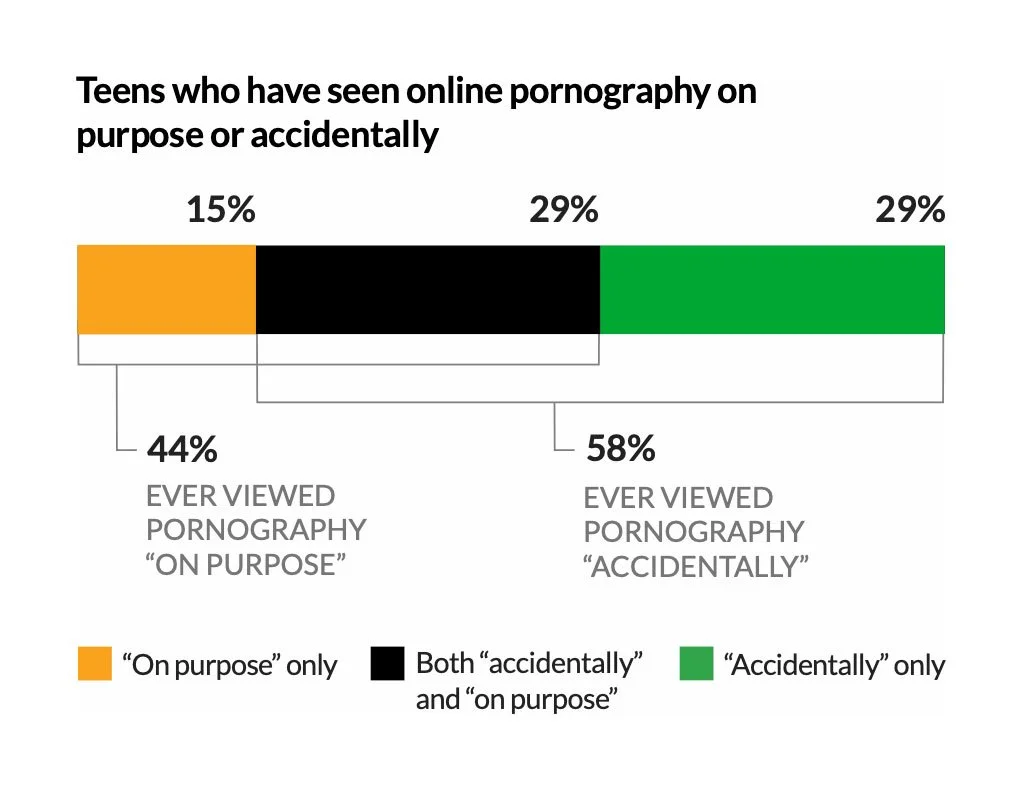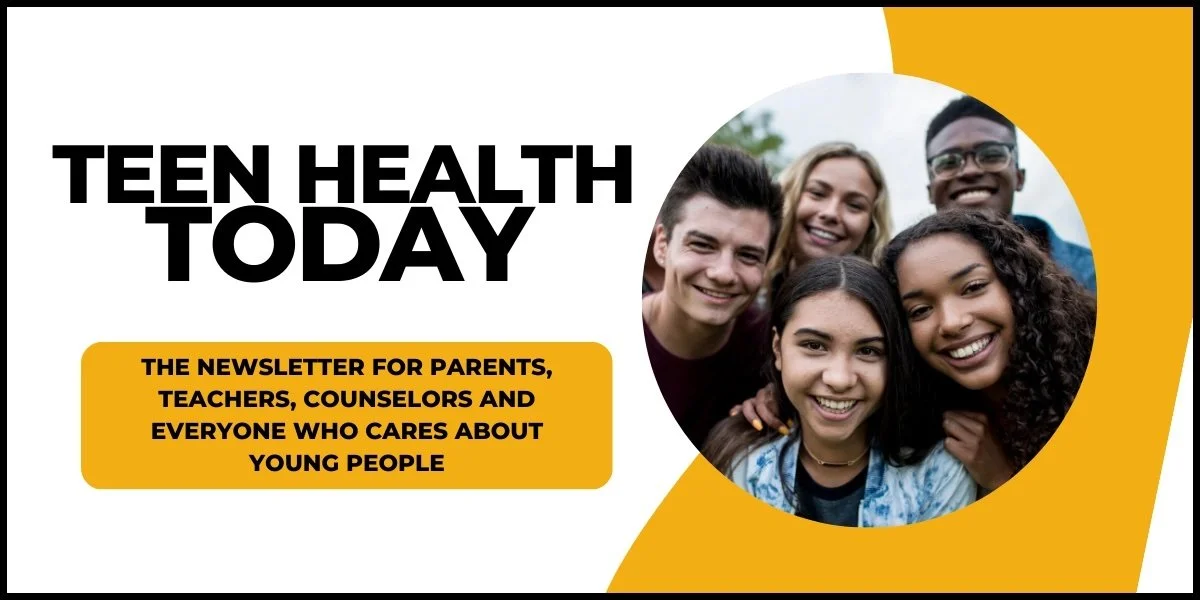How to Talk With Boys About Porn (Before the Internet Does)
Photo by Nick Fancher
The first time I saw porn was in my seventh grade classroom.
The boy sitting next to me slid his iPod Touch with the video already playing onto my desk while our teacher was explaining fractions. Not even my most beloved school subject—math—was safe from the unsought demonstrations of hyper-sexualized masculinity that characterize middle school.
My story isn’t unique. A 2014 study on Canadian adolescents found the average age of first exposure to porn was 12, with a third of participants saying they saw it as early as age 10. A more recent U.S. study from Common Sense Media found that 73% of teens reported having consumed pornography, and 31% of them said they had done so while at school.
I’ve worked with hundreds of young people, and I’ve seen how easy it is for them to turn to porn to try to answer their questions about sex and relationships.
As a woman in my 20s, I’ve also watched how it plays out in real life. In preparing for this blog, I started casually asking people about their early experiences with porn and dating—yes, I became that person who brings up porn at dinner parties.
What people shared lined up with the research. Many women described their first sexual experiences as disconnected and nonconsensual—shaped by what they and their partners had seen in porn. Acts like strangulation or slapping happened without any conversation, and the objectification of women was treated as normal. It was what many thought was ‘real sex.’
The men, for their part, said they were never really taught anything about porn. Most had used it as a guide—because no one told them not to. Without real conversations, they assumed what they saw was normal. It wasn’t until much later, often in their first serious relationships, that they began to understand how different real intimacy is from what’s portrayed on screen.
But one story stood out. A young man shared that one of his parents talked to him about porn before he ever saw it. “It wasn’t awkward,” he told me. “It actually made me feel more comfortable when I did eventually see it—I already knew what it was.” That early conversation helped him recognize that porn didn’t reflect real sex. By high school, he could see how it was shaping his peers, and he felt grateful to have been offered a different perspective.
That’s why I’m writing this post—for the parents who want to be that steady, open voice before the internet fills in the blanks. Because the truth is: your son will see porn. The question is whether he’ll have the context to understand it. And when that happens, will he be equipped to understand what he’s looking at?
This is about raising boys who grow into men who understand respect, consent, and real connection. So let’s talk about what they’re actually seeing, why it matters, and how to have ‘the talk’ in a way that includes what boys are seeing online.
Read more: Check out past Learnings & Unlearnings blog post, How Driver’s Ed Can Inspire the Way We Teach Consent to Middle School Boys.
My Kid Would Never—Right?
Listen, I get it—no parent wants to think about their kid watching porn. Of course, parental controls on devices are helpful, but they aren’t foolproof. Kids find workarounds: a classmate, a shared link, a meme that’s more than it seems.
In 2019, U.S. cybersecurity firm Webroot reported that about 35% of all internet downloads were pornographic. And the latest research from Common Sense Media ties into that—most teens say they’ve seen porn, but 58% say it happened by accident. Among the teens who said they had only ever seen porn by accident, 63% said they had been exposed to pornography in the past week. What this means is that even if your kid isn’t seeking it out, accidental exposure isn’t rare.
Mainstream porn teaches young people a lot about sex—but not what sex really is. It shows an unrealistic version that skips emotional connection, communication, and the human side of intimacy. A lot of what young people are watching isn’t even real—it's animated or AI-generated.
For example, Pornhub’s 2024 Year in Review reveals some notable trends. The top category in the U.S. was hentai—a style of pornified Japanese anime featuring characters who look young but with exaggerated adult anatomy, often involved in violent sexual acts. This type of content is growing fast, especially among Gen Z, who are nearly twice as likely to watch hentai compared to older generations. They also viewed gaming-related porn 151% more, with some of the most popular categories being Fortnite, Pokémon, and Minecraft.
Categories like “barely legal” and “teen” have long been among the most searched terms, even though Pornhub’s recent reports leave them out. This omission reveals a darker reality: porn frequently fetishizes underage or barely adult performers, with “teen” content so widespread it’s now woven into many other categories. Alongside this, mainstream porn’s objectification of women remains a serious problem and the precursor for the popularity of harmful categories connected to incest, coercion, and domination, which normalize sexual violence where verbal consent is very rarely shown. For young viewers, this can dangerously skew their understanding of what healthy, respectful intimacy truly means.
Mainstream porn often misrepresents both 2SLGBTQ+ and BIPOC people through stereotypes and harmful tropes. This is especially concerning since research shows that about two-thirds of LGBTQ+ teens watch porn—using it more than other teens to explore their identity and sexuality. Without authentic and respectful portrayals, porn can give these teens a narrow or distorted understanding of themselves and healthy relationships. At the same time, BIPOC performers are frequently fetishized or reduced to one-dimensional roles, shaping how young viewers perceive race and sex in damaging ways.
Surrounding all of that is Pornhub, which receives almost twice as much traffic as its nearest competitor. In recent years, it’s faced hundreds of lawsuits and serious accusations for hosting videos that include non-consensual acts, underage performers, and violent content. Public pressure has forced the site to improve age verification and content controls. Still, these issues reveal how dangerous and exploitative the online porn world can be.
Why This Conversation Matters (More Than Ever)
These trends matter because the messages they carry don’t just stay online—they shape how boys grow up thinking about themselves, their bodies, and their relationships with others. In a recent study by Australia’s eSafety Commissioner, for example, three quarters of teenagers thought that porn negatively impacted young people’s understanding of consent.
This is relevant for boys in particular. In a comparable study in the United Kingdom, more than half of boys said they thought that porn showed a realistic depiction of sex. Without guidance, boys are left to interpret those portrayals on their own—potentially internalizing harmful norms that reinforce objectification, entitlement and dominance.
Read more: In our report, Boys Will Be _: The Online Lives of Boys Who Are Embracing Positive Masculinity, we found that 41% of boys said they had learned most of what they know about sex online.
At Next Gen Men, we don’t talk with boys simply to prevent the worst from happening—we talk with them because they are already capable, curious, and committed to leading change. In fact, a majority of boys in that study also indicated that porn had led them to believe the sexual activities should be safe and enjoyable for everyone involved. This points to their capacity to be critical viewers of porn, but those skills don’t develop on their own.
“Overwhelmingly, we learned from young people that they understand that porn is a ‘fake’ commercial product. They generally know that it is a very poor guide to what real sex is like. Despite this, for many, it is a primary reference for finding out about sex – they simply don’t feel that they have any better source of information.”
By opening the door to honest, age-appropriate conversations early on, parents have a powerful opportunity to interrupt harmful messages and instead model values like consent, equality, empathy, and emotional connection. In a world where masculinity is too often shaped by silence or screens, your voice matters more than ever.
Let’s get into it.
🧠 The P.O.R.N. Talk Framework
P — Prepare Yourself First
A friend of mine was driving her son to the dentist (“To the dentist!”) when he piped up from the backseat, “Mom, what’s a threesome?”
You know better than I do that kids rarely wait for the right moment to spring something on you. They bring up uncomfortable topics whether you’re ready for it or not. Sometimes they bring them up while you’re stopped at a traffic light, eyeing the fact that Google Maps is projecting you’ll be six minutes late to your kid’s dentist appointment.
You also probably know that most boys are expert readers of emotional discomfort. So before you head into a conversation about sex and porn, take a moment to reflect on your own feelings and beliefs.
How did you learn about these topics growing up?
Were those conversations open and helpful, or awkward and confusing?
What would you want to do differently for your kid?
Understanding your own experiences and values helps you approach the conversation calmly and thoughtfully—not from fear or judgment. It also prepares you to respond with empathy, especially when your child’s questions or reactions might surprise you. Remember, your goal isn’t to have all the answers, but to create a safe space where your child feels comfortable talking honestly.
“These are skills your kids can use in their lives as they get older, when they are talking to partners or possibly raising kids of their own. You are taking steps to help raise people who are empathetic, caring, and who think critically about what they see in the world.
It’s worth a few minutes of awkwardness.”
O — Open the Conversation Early
Don’t wait for your child to bring up porn—start the conversation before they encounter it. Begin by explaining what porn is in simple terms: it’s videos or pictures made for adults that show people having sex. But it’s not like real life—it’s a kind of entertainment that leaves out important parts like feelings, respect, and communication.
Then introduce the media literacy idea of suspending disbelief. This is what happens when we watch movies or shows—we accept things that aren’t real so we can enjoy the story. For example, a lot of boys love Spider-Man because he swings between buildings and has superpowers, but they know he’s not real and don’t expect to be able to shoot webs from their wrists.
Porn is tricky because it looks real, but it’s a show or a performance. Just like Spider-Man’s powers aren’t real, porn shows a made-up version of sex that doesn’t reflect how real people connect, respect each other, or ask for consent.
R — Respond Without Shame
Parents largely get left out of the conversation. A study in New Zealand found that only one in twenty young people raised the topic of porn with a parent or caregiver.
Four in five young people in the eSafety Commissioner’s study said that feeling embarrassed, judged or shamed was the main reason that young people might not seek help managing the negative impacts of porn.
As my colleague Jonathon put it: “If your preteen son stayed up late watching The Fast and the Furious, he could feel pretty comfortable coming downstairs in the morning and saying, “Hey, I watched a really intense car chase last night…that’s not how you actually drive a car, is it?”
“He probably couldn’t do the same to unpack the differences between pornography and loving, intimate relationships. Why not?”
Read more: Dive deeper into boys and porn in past Learnings & Unlearnings blog, What Should Parents of Boys Know About Porn?
Research shows that when parents react with awkwardness, anger or shame, kids often shut down and avoid future conversations about sex or porn. Instead, staying calm and open helps build trust and encourages ongoing dialogue. Let your child know their curiosity is normal and that they’re not in trouble.
N — Normalize Media Literacy
The skills involved in viewing porn critically aren’t just about porn. As Peggy Orenstein writes in Boys & Sex: “It’s the persistent depiction of women as things, and in degrading and compliant roles, that is the problem—and that is abundantly on display in the mainstream media boys consume throughout their lives.”
Helping your child think critically about what they see—whether it’s porn, social media, or just TV and movies—helps keep them connected with their own values. So use everyday moments, like watching their latest show, scrolling through TikTok, or catching a movie together, to talk about how people treat each other.
These chats help your child spot the difference between entertainment and real life—and it’s a great way to share and talk about what values matter most to you as a family.
The way we see it, it’s not your job to understand and control your child’s social media. You may not be the expert in social media or pop culture, but if you play your cards right, you may be an expert on the young person you call your own.
Read more: If you are interested in learning more about how to talk about porn, our friend Christopher Pepper writes Teen Health Today, an exceptional resource on youth well-being and development that includes How To Talk To Kids About P-O-R-N.
You Don’t Have to Get It Perfect—Just Get It Started
You don’t need to be a sex ed expert. You just need to show up.
Kids don’t expect you to know everything. What they’re really looking for is a safe adult—someone who listens without judgment, tells the truth without shame, and makes it okay to be curious. The conversation about porn isn’t just about screens or sex acts; it’s about the bigger things: values, relationships, respect, and safety. It’s a chance to help your son understand the difference between performance and connection, between what he sees online and what he deserves in real life.
“Young people are telling us that they would hugely value the opportunity to have safe, honest and non-judgemental discussions with adults about sex and porn.”
And here’s the good news: this doesn’t have to be one perfect conversation. In fact, it’s better if it isn’t. These chats can—and should—happen in small, honest moments over time. What matters most is that your son knows he can come to you with questions, and that when he does, you’ll be there. That sense of trust, safety, and openness is one of the greatest gifts you can give him as he grows into his own version of manhood—one rooted not in silence or shame, but in care, clarity, and connection.




